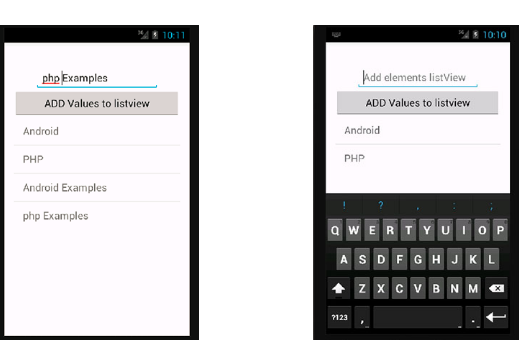Who can explain or suggest a tutorial for creating listView in Android?
This is my request:
- I should be able to add new elements dynamically by pressing the button.
- It should be simple enough to understand (for example, there may not be any performance improvements or convertview)
I know there are many questions about this topic, which are posted on StackOverflow here, but I can't find any questions to answer my questions. Thank you!
#1 building
replace
listItems.add("New Item"); adapter.notifyDataSetChanged();
You can call directly
adapter.add("New Item");
#2 building
First, you must add a ListView, an EditText, and a button to activity main.xml.
Now, in your ActivityMain:
private EditText editTxt; private Button btn; private ListView list; private ArrayAdapter<String> adapter; private ArrayList<String> arrayList; @Override protected void onCreate(Bundle savedInstanceState) { super.onCreate(savedInstanceState); setContentView(R.layout.activity_main); editTxt = (EditText) findViewById(R.id.editText); btn = (Button) findViewById(R.id.button); list = (ListView) findViewById(R.id.listView); arrayList = new ArrayList<String>(); // Adapter: You need three parameters 'the context, id of the layout (it will be where the data is shown), // and the array that contains the data adapter = new ArrayAdapter<String>(getApplicationContext(), android.R.layout.simple_spinner_item, arrayList); // Here, you set the data in your ListView list.setAdapter(adapter); btn.setOnClickListener(new View.OnClickListener() { @Override public void onClick(View view) { // this line adds the data of your EditText and puts in your array arrayList.add(editTxt.getText().toString()); // next thing you have to do is check if your adapter has changed adapter.notifyDataSetChanged(); } }); }
This is useful to me, I hope it will help you
#3 building
If you want to use ListView instead of ListActivity in AppCompatActivity, you can do the following (modify @ Shardul's answer):
public class ListViewDemoActivity extends AppCompatActivity { //LIST OF ARRAY STRINGS WHICH WILL SERVE AS LIST ITEMS ArrayList<String> listItems=new ArrayList<String>(); //DEFINING A STRING ADAPTER WHICH WILL HANDLE THE DATA OF THE LISTVIEW ArrayAdapter<String> adapter; //RECORDING HOW MANY TIMES THE BUTTON HAS BEEN CLICKED int clickCounter=0; private ListView mListView; @Override public void onCreate(Bundle icicle) { super.onCreate(icicle); setContentView(R.layout.activity_list_view_demo); if (mListView == null) { mListView = (ListView) findViewById(R.id.listDemo); } adapter=new ArrayAdapter<String>(this, android.R.layout.simple_list_item_1, listItems); setListAdapter(adapter); } //METHOD WHICH WILL HANDLE DYNAMIC INSERTION public void addItems(View v) { listItems.add("Clicked : "+clickCounter++); adapter.notifyDataSetChanged(); } protected ListView getListView() { if (mListView == null) { mListView = (ListView) findViewById(R.id.listDemo); } return mListView; } protected void setListAdapter(ListAdapter adapter) { getListView().setAdapter(adapter); } protected ListAdapter getListAdapter() { ListAdapter adapter = getListView().getAdapter(); if (adapter instanceof HeaderViewListAdapter) { return ((HeaderViewListAdapter)adapter).getWrappedAdapter(); } else { return adapter; } } }
In your layout, you can use android:id="@+id/listDemo" instead of android:id=“ @android:id/list" android:id="@+id/listDemo"
So now you can have a ListView in a normal AppCompatActivity.
#4 building
Code for MainActivity.java file.
public class MainActivity extends Activity { ListView listview; Button Addbutton; EditText GetValue; String[] ListElements = new String[] { "Android", "PHP" }; @Override protected void onCreate(Bundle savedInstanceState) { super.onCreate(savedInstanceState); setContentView(R.layout.activity_main); listview = (ListView) findViewById(R.id.listView1); Addbutton = (Button) findViewById(R.id.button1); GetValue = (EditText) findViewById(R.id.editText1); final List < String > ListElementsArrayList = new ArrayList < String > (Arrays.asList(ListElements)); final ArrayAdapter < String > adapter = new ArrayAdapter < String > (MainActivity.this, android.R.layout.simple_list_item_1, ListElementsArrayList); listview.setAdapter(adapter); Addbutton.setOnClickListener(new View.OnClickListener() { @Override public void onClick(View v) { ListElementsArrayList.add(GetValue.getText().toString()); adapter.notifyDataSetChanged(); } }); } }
The code for the activity main.xml layout file.
<RelativeLayout xmlns:android="http://schemas.android.com/apk/res/android" xmlns:tools="http://schemas.android.com/tools" android:layout_width="match_parent" android:layout_height="match_parent" android:paddingBottom="@dimen/activity_vertical_margin" android:paddingLeft="@dimen/activity_horizontal_margin" android:paddingRight="@dimen/activity_horizontal_margin" android:paddingTop="@dimen/activity_vertical_margin" tools:context="com.listviewaddelementsdynamically_android_examples .com.MainActivity" > <Button android:id="@+id/button1" android:layout_width="fill_parent" android:layout_height="wrap_content" android:layout_below="@+id/editText1" android:layout_centerHorizontal="true" android:text="ADD Values to listview" /> <EditText android:id="@+id/editText1" android:layout_width="wrap_content" android:layout_height="wrap_content" android:layout_alignParentTop="true" android:layout_centerHorizontal="true" android:layout_marginTop="26dp" android:ems="10" android:hint="Add elements listView" /> <ListView android:id="@+id/listView1" android:layout_width="match_parent" android:layout_height="wrap_content" android:layout_below="@+id/button1" android:layout_centerHorizontal="true" > </ListView> </RelativeLayout>
Screenshots
#5 building
First, create the XML layout in the res/layout/main.xml folder of the project:
<?xml version="1.0" encoding="utf-8"?> <LinearLayout xmlns:android="http://schemas.android.com/apk/res/android" android:orientation="vertical" android:layout_width="fill_parent" android:layout_height="fill_parent" > <Button android:id="@+id/addBtn" android:text="Add New Item" android:layout_width="fill_parent" android:layout_height="wrap_content" android:onClick="addItems"/> <ListView android:id="@android:id/list" android:layout_width="fill_parent" android:layout_height="fill_parent" android:drawSelectorOnTop="false" /> </LinearLayout>
This is a simple layout with a button at the top and a list view at the bottom. Note that ListView has an ID @android : id/list, @ android:id/list defines the default ListView that ListActivity can use.
public class ListViewDemo extends ListActivity { //LIST OF ARRAY STRINGS WHICH WILL SERVE AS LIST ITEMS ArrayList<String> listItems=new ArrayList<String>(); //DEFINING A STRING ADAPTER WHICH WILL HANDLE THE DATA OF THE LISTVIEW ArrayAdapter<String> adapter; //RECORDING HOW MANY TIMES THE BUTTON HAS BEEN CLICKED int clickCounter=0; @Override public void onCreate(Bundle icicle) { super.onCreate(icicle); setContentView(R.layout.main); adapter=new ArrayAdapter<String>(this, android.R.layout.simple_list_item_1, listItems); setListAdapter(adapter); } //METHOD WHICH WILL HANDLE DYNAMIC INSERTION public void addItems(View v) { listItems.add("Clicked : "+clickCounter++); adapter.notifyDataSetChanged(); } }
Android.r.layout.simple menu list item 1 is the default list item layout provided by Android. You can use this inventory layout for non complex things.
listItems is a List that holds the data displayed in the ListView. All inserts and deletions should be done on listItems; listItems changes should be reflected in the view. This is notified by arrayadapter < string > adapter using the following methods:
adapter.notifyDataSetChanged();
The adapter is instantiated with three parameters: the context, which can be your activity/listactivity; the layout of your individual list items; and finally the list, which is the actual data to be displayed in the list.
